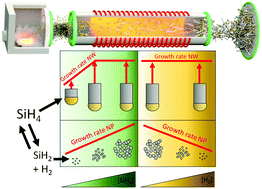Controlling reaction paths for ultra-fast growth of inorganic nanowires floating in the gas phase†
Abstract
Synthesis of inorganic nanowires/nanotubes suspended in the gas through floating catalyst chemical vapour deposition (FCCVD) produces exceptional growth rates of 5–1000 micron per second, several orders of magnitude faster than conventional substrate processes. It leads to nanowire lengths >100 microns and thus to the possibility of direct assembly into freestanding macroscopic networks as a continuous process. This work studies the different reaction paths controlling conversion and selectivity in FCCVD applied to the synthesis of silicon nanowires (SiNWs) from silane, grown through an aerosol of gold catalyst nanoparticles. There are two main competing reactions: catalysed growth of SiNWs and non-catalysed formation of amorphous Si nanoparticles. The mass fraction of the two populations can be precisely determined by XRD and Raman spectroscopy, enabling high-throughput screening of reaction parameter space. The experimental data and accompanying analytical model show that selectivity is kinetically controlled by the ratio of precursor/hydrogen carrier gas, through its inhibition of the pyrolisis of silane into silylene. In contrast, the rate of SiNW growth is largely unaffected by hydrogen and not limited by precursor availability. These results provide a framework to describe the kinetics of nanomaterials growth by FCCVD.



 Please wait while we load your content...
Please wait while we load your content...